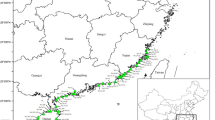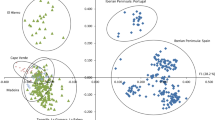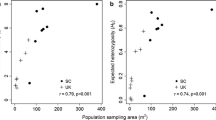Abstract
The conservation status of Euchresta japonica Hook. f. ex Regel in Korea was investigated, with an emphasis on its genetic diversity. From field surveys, we obtained the only locality record for a wild population in Korea, which contained eight individuals. Genotyping was performed using nine microsatellite markers for all 20 remaining individuals, including those in ex situ collections. Among nine microsatellite loci that amplified within this group, five showed polymorphism with low hererozygosities, and a total of 12 multilocus genotypes were detected. Wild-specific alleles were detected in two individuals, and ex situ-specific alleles were detected in six individuals. Five individuals proved to have individual-specific alleles. The Korean population was also distinguished from the previously reported Japanese population by different alleles and higher diversity. To conserve this species more effectively in Korea, we recommend the following: (1) fencing the remaining wild population; (2) no relocation of wild individuals, as nine ex situ plants are already available; (3) complete ex situ conservation of all genetic diversity via clonal propagation of wild individuals; and (4) continuous protection and monitoring of the wild population.
Similar content being viewed by others
References
Bernardos S, Amado A, Amich F (2006) The narrow endemic Scrophularia valdesii Ortega-Olivencia & Devesa (Scrophulariaceae) in the Iberian Peninsula: an evaluation of its conservation status. Biodivers Conserv 15:4027–4043
Lande R (1988) Genetics and demography in biological conservation. Science, 241:1455–1460
Ehrenfeld D (2006) Transgenics and vertebrate cloning as tools for species conservation. Conserv Biol 20:723–732
Frankham R (1995) Conservation genetics. Annu Rev Genet 29:305–327
Fu LG, Jin JM (1992) The red book of Chinese plants-rare and endangered plants, Vol 1. Science Press, Beijing
Goudet J (2001) Fstat, a program to estimate and test gene diversities and fixation indices Version 2.9.3. Available from http://www2.unil.ch/popgen/softwares/fstat.htm (accessed July 2012)
Guerrant EO, Havens K, Maunder M (2004) Ex situ plant conservation: supporting species survival in the wild. Island Press, Washington, DC
Hama I, Saito Y, Umehara C, Lian CL, Ide Y (2009) Development of microsatellite markers for Euchresta japonica and E. formosana (Leguminosae). Mol Ecol Resour 9:1188–1190
Hang S, Larsen K (2010) Tribe Euchresteae. In ZY Wu, PH Raven, eds, Flora of China 10. Science Press, Beijing and Missouri Botanical Garden Press, St. Louis, pp 98–99
Izuno A, Takamiya M, Kaneko S, Isagi Y (2012) Genetic variation and structure of the endangered Lady Fern Athyrium viridescentipes based on ubiquitous genotyping. J Plant Res 125:613–618
Kaneko S, Abe T, Isagi Y (2013) Complete genotyping in conservation genetics, a case study of a critically endangered shrub, Stachyurus macrocarpus var. prunifolius (Stachyuraceae) in the Ogasawara Islands, Japan. J Plant Res (in press)
Kim CS (2006) Studies on the distribution and vegetation of the endangered wild plant in Jeju Island. Ph. D. thesis. Jeju National University, Jeju
Keller LF, Waller DM (2002) Inbreeding effect in wild populations. Trends Ecol Evol 17:230–241
Korea Forest Service (2008) Rare plants data book in Korea. Korea National Arboretum, Pocheon
Krauss SL, Dixon B, Dixon KW (2002) Rapid genetic decline in a translocated population of the endangered plant Grevillea scapigera. Conserv Biol 16:986–994
Ku YB, Oh HK, Shim KY, Kim MS, Lee SM (2006) Growth characteristics, genetic diversity and conservation of endangered plants (I): the case of Astiloboides tabularis, Euchresta japonica, Echinosophora koreensis and Lilium cernuum. National Institute of Environmental Research of Korea, Incheon
Leimu R, Mutikainen P, Koricheva J, Fischer M (2006) How general are positive relationships between plant population size, fitness and genetic variation? J Ecol 94:942–952
Li YY, Chen XY, Zhang X, Wu TY, Lu HP, Cai YW (2005) Genetic differences between wild and artificial populations of Metasequoia glyptostroboides Hu et Cheng (Taxodiaceae): Implications for species recovery. Conserv Biol 19:224–231
Li YY, Guan SM, Yang SZ, Luo Y, Chen XY (2012) Genetic decline and inbreeding depression in an extremely rare tree. Conserv Genet 13:343–347
Milligan B (1992) Plant DNA isolation. In AR Hoelzel, ed, Molecular genetic analysis of populations: a practical approach. IRL Press, Oxford, pp 59–88
Ministry of Environment (2005) Wildlife Protection Act. Ministry of Environment of Korea, Gwacheon
Namoff S, Husby CE, Francisco-Ortega J, Noblick LR, Lewis CE, Griffith MP (2010) How well does a botanical garden collection of a rare palm capture the genetic variation in a wild population? Biol Conserv 143:1110–1117
Neel MC, Ellstrand NC (2001) Patterns of allozyme diversity in the threatened plant Erigeron parishii (Asteraceae). Am J Bot 88:810–818
Ohashi H (1978) The taxonomy and distribution of Euchresta japonica (Leguminosae). Bot Mag Tokyo 91:291–294
Ohashi H (2001) Leguminosae (Fabaceae). In K Iwatsuki, DE Boufford, H Ohba, eds, Flora of Japan 2b. Kodansha, Tokyo, pp 213–279
Ouborg NJ, Vergeer P, Mix C (2006) The rough edges of the conservation genetics paradigm for plants. J Ecol 94:1233–1248
Robichaux RH, Friar EA, Mount DW (1997) Molecular genetic consequences of a population bottleneck associated with reintroduction of the Mauna Kea silversword (Argyroxiphium sandwicense ssp. sandwicense [Asteraceae]). Conser Biol 11:1140–1146
Schaal BA, Leverich WJ, Rogstad SH (1991) A comparison of methods for assessing genetic variation in plant conservation biology, In DA Falk, KE Holsinger, eds, Genetics and Conservation of Rare Plants. Oxford University Press, New York, pp 123–134
Shiga T, Yokogawa M, Kaneko S, Isagi Y (2013) Genetic identification for trading plants of endangered macrophyte, Nuphar submersa and N. xfluminalis (Nymphaeaceae) based on genotype data of all remnant individuals growing in the wild. Jpn J Cons Ecol 18: 33–44
Song GP, Jang CG, Kang SH (2012) Conservation and vegetation structure of Euchresta japonica (Leguminosae) in Jeju Island. Kor J Plant Res 25:89–95
Song SY (2010) Studies on seed germination and in vitro propagation of Euchresta japonica Benth., a rare and endangered species. M. Sc. thesis. Jeju National University, Jeju
Vergeer P, Ouborg NJ, Hendry AP (2008) Genetic considerations of introduction efforts. In SP Carroll, CW Fox, eds, Conservation biology-evolution in action. Oxford University Press, Oxford, pp 116–129
Willi Y, Van Buskirk J, Hoffmann AA (2006) Limits to the adaptive potential of small populations. Annu Rev Ecol Evol S 37:433–458
Yokogawa M, Kaneko S, Takahashi Y, Isagi Y (2013) Genetic consequences of rapid population decline and restoration of the critically endangered herb Polemonium kiushianum. Biol Conserv 157:401–408
Zurbuchen A (2010) Distance matters: impact of increasing foraging distances on population dynamics in native bees. Ph. D. thesis. ETH Zurich, Zurich
Author information
Authors and Affiliations
Corresponding author
Rights and permissions
About this article
Cite this article
Choi, HJ., Kaneko, S., Yokogawa, M. et al. Population and genetic status of a critically endangered species in Korea, Euchresta japonica (Leguminosae), and their implications for conservation. J. Plant Biol. 56, 251–257 (2013). https://doi.org/10.1007/s12374-013-0106-6
Received:
Accepted:
Published:
Issue Date:
DOI: https://doi.org/10.1007/s12374-013-0106-6




